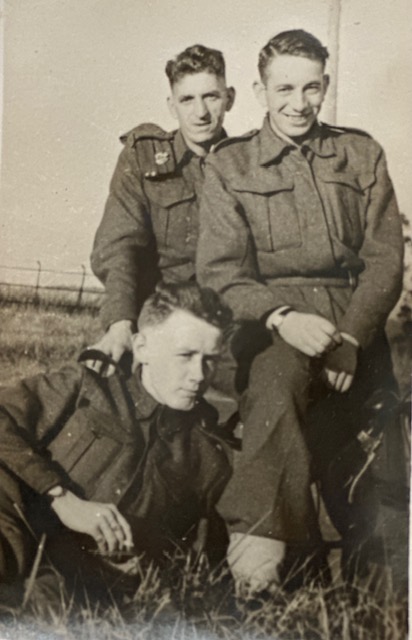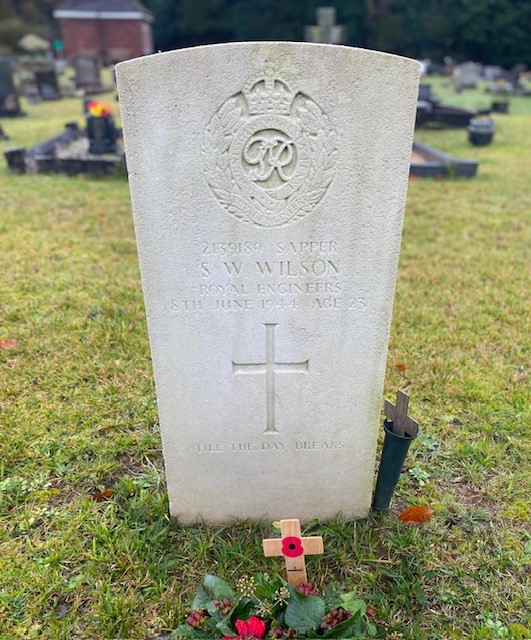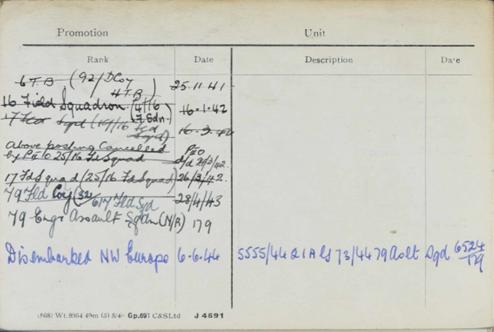Stanley William Wilson and Operation Overlord
Stanley William Wilson, or Sonny to his family and friends, resided at 22 South View, Broughton.

Sonny’s Story
Sonny worked at Scunthorpe Steelworks. Exempt from National Service, he volunteered to enlist into the Army with his best friends on 20 February 1941, aged just 21.
He joined the Royal Engineers. After completing his basic training, on 16 January 1942 he was assigned to the 16th Field Squadron. This engineering squadron were tasked to defend the coastal areas from Tyne Tees to the Humber Estuary.

Sonny was posted to the 79th Engineers Assault Squadron in 1943. This Squadron were fondly remembered as Hobart’s Funnies, when they adapted various armoured vehicles for D-Day.
On the morning of 6 June 1944, the 79th Squadron under the command of the British 3rd Division were tasked to clear the shore of all mines and explosive devices prior to the main landing.
6 June 1944 0706hrs
The British Army had dedicated teams of Assault Engineers to land before anyone else, with the task of clearing the beach obstacles. This they did. Unfortunately, the water and tide driven by the wind made a much higher water mark than anticipated. The Assault Engineers continued to make the beach obstacles safe, by continuing to swim amongst the defences removing mines and shells, as the tide rose even higher, many of those men while still carrying on with their tasks were drowned. But their sacrifice made everything possible.
Extract from the notes of a Canadian Officer at Sword Beach.
Sonny was one of the first to land on Sword Beach as part of the dedicated team of Engineers tasked to clear the beach. He died from his injuries two days later on 8 June 1944.
Sonny is buried at Broughton Cemetery, Commonwealth War Grave 182. He is also remembered at British Normanby Memorial Ver-Sur-Mer, Column 27.

Operation Overlord
The Battle of Normandy, or Operation Overlord, was the Allied operation that launched the successful liberation of German-occupied Western Europe during the Second World War.
Operation Overlord was launched on 6 June 1944, D-Day, with the Normandy landings, Operation Neptune. A 1,200-plane airborne assault preceded an amphibious assault involving more than 5,000 vessels. Nearly 160,000 troops crossed the English Channel on 6 June. The coastline of Normandy was divided into codenames: Utah, Omaha, Gold, Juno and Sword.
Sword Beach Landings
Sword Beach, located between Saint-Aubin to Ouistreham, was the target for the British 3rd Infantry Division, consisting of 29,000 troops. The invasion started at 07:25, H-Hour. Sword Beach was defended by the 716th German Infantry Division, supported by the 736th and 125th Regiments along with the 21st Panzer Division.
Twenty minutes prior to H-Hour the 79th Assault engineers had cleared the way of ordinance with heavy casualties to the Squadron. The invading forces landed at 07:25 hours on D-Day and were greeted with moderate fire. They were able to put out suppressing fire, and by 08:00 hours the fighting was mostly now inland with 630 British casualties.
D-Day was at that time the largest invasion force in history. 326,000 troops landed on German occupied French territory. Operation Overlord’s success put the Allies on a decisive path toward victory. Beginning with the Normandy beaches, they pushed back against Axis forces until Germany was forced to surrender less than a year later.



